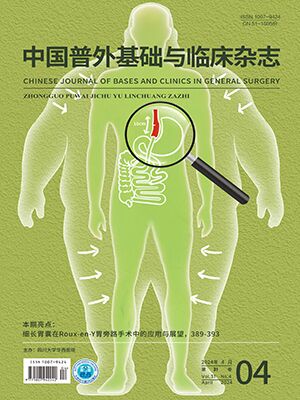| 1. |
Boutros C, Gary M, Baldwin K, et al.Gallbladder cancer:past, present and an uncertain future[J].Surg Oncol, 2012, 21(4):183-191.
|
| 2. |
Sugihara E, Saya H.Complexity of cancer stem cells[J].Int J Cancer, 2013, 132(6):1249-1259.
|
| 3. |
俞远林, 姜波健, 俞继卫, 等.免疫磁珠法分离胆囊癌CD133阳性细胞及生物学行为的研究[J].中华实验外科杂志, 2012, 30(8):1652-1655.
|
| 4. |
Domanska UM, Timmer-Bosscha H, Nagengast WB, et al.CXCR4 inhibition with AMD3100 sensitizes prostate cancer to docetaxel chemotherapy[J].Neoplasia, 2012, 14(8):709-718.
|
| 5. |
陆瑞祺, 吴巨钢, 周国才, 等.胃癌C D133阳性细胞亚群肿瘤起始细胞样特性的检测[J].中华胃肠外科杂志, 2012, 15(2):174-179.
|
| 6. |
Ricci-Vitiani L, Lombardi DG, Pilozzi E, et al.Identification and expansion of human colon-cancer-initiating cells[J].Nature, 2007, 445(7123):111-115.
|
| 7. |
Galli R, Binda E, Orfanelli U, et al.Isolation and characterization of tumorigenic, stem-like neural precursors from human glioblastoma[J].Cancer Res, 2004, 64(19):7011-7021.
|
| 8. |
Bao S, Wu Q, McLendon RE, et al.Glioma stem cells promote radioresistance by preferential activation of the DNA damage res-ponse[J].Nature, 2006, 444(7120):756-760.
|
| 9. |
Yin S, Li J, Hu C, et al.C D133 positive hepatocellular carcinoma cells possess high capacity for tumorigenicity[J].Int J Cancer, 2007, 120(7):1444-1450.
|
| 10. |
Müller A, Homey B, Soto H, et al.Involvement of chemokine receptors in breast cancer metastasis[J].Nature, 2001, 410(6824):50-56.
|
| 11. |
Saur D, Seidler B, Schneider G, et al.CXCR4 expression incr-eases liver and lung metastasis in a mouse model of pancreatic cancer[J].Gastroenterology, 2005, 129(4):1237-1250.
|
| 12. |
Schimanski CC, Schwald S, Simiantonaki N, et al.Effect of chemokine receptors CXCR4 and CCR7 on the metastatic behaviorof human colorectal cancer[J].Clin Cancer Res, 2005, 11(5):1743-1750.
|
| 13. |
Lee HJ, Lee K, Lee DG, et al.Chemokine (C-X-C motif) ligand 12 is associated with gallbladder carcinoma progression and is a novel independent poor prognostic factor[J].Clin Cancer Res, 2012, 18(12):3270-3280.
|
| 14. |
Yao X, Zhou L, Han S, et al.High expression of CXCR4 and CXCR7 predicts poor survival in gallbladder cancer[J].J Int Med Res, 2011, 39(4):1253-1264.
|
| 15. |
Sun X, Cheng G, Hao M, et al.CXCL12/CXCR4/CXCR7 chemokine axis and cancer progression[J].Cancer Metastasis Rev, 2010, 29(4):709-722.
|
| 16. |
Ping YF, Yao XH, Jiang JY, et al.The chemokine CXCL12 and its receptor CXCR4 promote glioma stem cell-mediated VEGF production and tumour angiogenesis via PI3K/AKT signalling[J]. J Pathol, 2011, 224(3):344-354.
|
| 17. |
姜海广, 陆瑞祺, 姜波健, 等.基质细胞源性因子-1α/CXC趋化因子受体-4轴经PI3K/Akt通路对胃癌细胞CD133表达的调控作用[J].中华实验外科杂志, 2012, 29(3):378-380.
|
| 18. |
Zhang SS, Han ZP, Jing YY, et al.C D133+CXCR4+colon cancer cells exhibit metastatic potential and predict poor prognosis of patients[J].BMC Med, 2012, 10:85.
|




